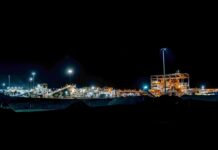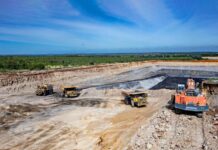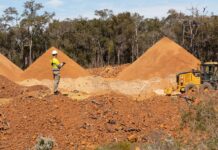Whitehaven Coal: Australia’s leading coal producer

Australia’s leading coal producer Whitehaven Coal (ASX: WHC) operates seven mines — six open cut and one underground — in the Gunnedah Coal Basin in NSW and Bowen Basin in Queensland.
Due to its unique properties, including the fact it delivers among the lowest carbon emissions per tonne of coal consumed in the seaborne trade, Whitehaven’s coal is highly sought after across international markets, particularly Asia.
Along with metallurgical coal, Whitehaven produces a premium thermal coal product, which is also high-energy, low-ash and low-sulphur, for use in high-efficiency, low emissions coal fired power stations.
In the first of a two-part series on Whitehaven Coal, the Australian Mining Review looks at some of the company’s operations and development plans in NSW and Queensland.
Maules Creek
Beginning operations in 2015, the open cut Maules Creek mine produces some of the highest quality high energy thermal coal in Australia.
Whitehaven owns 75% of the mine and is the operator, with the other 25% owned by Itochu (15%) and J Power (10%).
The mine has coal reserves to support 40 years of production and sales are expected to deliver $2.4b in royalties in the first 21 years of production.
In the March quarterly production report (Q3 FY24), Maules Creek continued to deliver strong operational performance, holding up overall run-of-mine (ROM) production.
The March quarter ROM production across Whitehaven Coal was 4.4mt, or 13% lower than the December quarter, with the Maules Creek ROM production of 2.8mt for the quarter, down 12% on the previous quarter in line with the mine plan.
It continued the strong performance achieved in H1 FY24, with 8.8mt for the 9-months ended Mar-24 up 42% on the prior year.
Whitehaven Coal managing director and chief executive Paul Flynn commented on the results.
“In the March quarter, Whitehaven produced 4.4mt of ROM production with Maules Creek and the Gunnedah open cut mines continuing to deliver strong operational performance,” he said.
A decision to conclude the autonomous haulage trial and resume fully manned operations was taken during the quarter and the mine is now operating fully manned.
The company’s FY23 annual report stated lower ROM coal production of 9.55mt due to a range of factors including: labour constraints; congestion arising from limited dumping locations while keeping manned and unmanned autonomous haulage system (AHS) fleets separate; and ongoing intermittent weather and in-pit water management.
Whitehaven is on track to meet overall guidance for ROM production of 18.7– 20.7mt and sales volumes, with Maules Creek and Gunnedah open cuts mines tracking above the top end of guidance while production from Narrabri is tracking below guidance.
Maules Creek is tracking above its FY24 guidance of 10.1-11.2mt.
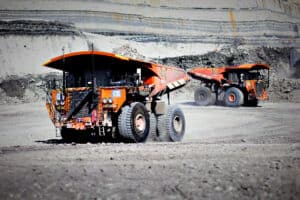
Tarrawonga
Tarrawonga has been part of Whitehaven’s business since its formation in 1999 with the mine producing 3.5mtpa of run-of-mine (ROM) high-quality thermal coal and semi-soft coking coal with reserves to support more than 20 years of coal extraction.
Werris Creek
Werris Creek produces 2.5mtpa of thermal and pulverised coal injection (PCI) coal and has resources to support production until 2024. This coal has low to medium ash, low sulphur, low phosphorous and medium to high volatility.
The coal is transported by rail to the Port of Newcastle where it’s exported to Asia.
Narrabri
Narrabri Mine is Whitehaven’s only underground operation and it’s been approved to produce 11mtpa of high-quality thermal coal until 2031.
Under the Stage 3 extension project, Whitehaven is proposing to extract coal to the south of the existing mine, extending the life of mine to 2044.
Winchester South Approval
In February 2024, Whitehaven received approval from the Queensland Department of Environment, Science and Innovation to approve the $1b Winchester South open cut coal mine.
Acquired from Rio Tinto in 2018, Winchester South lies 30km southeast of Moranbah, adjacent to the Daunia metallurgical coal mine.
Winchester South is expected to produce up to 17mtpa of primarily metallurgical ROM coal from an estimated 380mt of reserves which will supply the international steelmaking market for 30 years.
“The Coordinator General recommendation is an important milestone for Whitehaven, for the people of Queensland and for our trading partners who rely on Australia’s high-quality metallurgical coal, which is essential for steel production,” the February announcement stated.
The project will involve the construction of a coal processing plant and a rail loop to connect with the existing Bowen Basin coal rail network.
With its location in a well-established region, the site has direct access to key rail and port infrastructure, providing multiple coal export options.
As part of the assessment process, potential impacts were studied with a design created that aims to avoid, minimise or offset environmental and other impacts.
Key features include fully abating Scope 2 emissions through the purchase of carbon neutral electricity, reducing the number of final voids from four to three and proposing a final land use of agricultural water storage for these three voids.
Additionally, Whitehaven worked to identify and minimise environmental impacts for Winchester South with key features including:
• Minimal impacts to air, noise and water quality and supply to surrounding landowners
• No impact on nearby strategic cropping areas
• Whitehaven will rehabilitate the land progressively as it’s mined and after mining there will be no residual voids in the Isaac River floodplain
• The area will be rehabilitated for agricultural use, with residual voids proposed to be used for agricultural water storage
• Biodiversity impacts would be offset in accordance with government guidelines
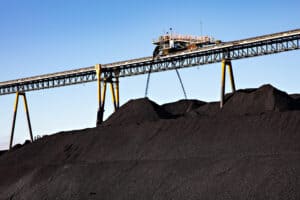
Environmental, Social and Governance Practices
As mining is a highly regulated industry, all of Whitehaven’s projects adhere to the strict environmental controls with independent advice forming the basis of managing any potential impacts to surface water, groundwater, flora, fauna, Aboriginal cultural heritage, historic heritage, air quality, noise, agriculture and geochemistry.
Whitehaven’s adherence to these plans are monitored and independently monitored every three years.
In FY23, Whitehaven enhanced its proactive risk management through coaching in critical control monitoring and material risk evaluation, it implemented improvements in rehabilitation and disturbance monitoring activities, and improved the identification of hazards associated with environmental, regulatory and reputational risk.
Looking Forward
According to Whitehaven’s FY24 half year results, underlying demand for thermal coal remains strong, including the supply to high-efficiency, low emissions electricity generation in traditional and emerging markets across Asia.
“The uncertainty and volatility we have seen in the global energy market has further validated the enduring role Whitehaven Coal plays in supporting global access to energy for industrial activity and economic development over the long term,” Whitehaven managing director and chief executive Paul Flynn said in the company’s 2023 Sustainability Report.
“The energy transition will take many decades and high-quality, high-calorific value thermal coal will continue to be an important resource.”
Whitehaven remains on track to meet its ROM production of 18.7mt – 20.7mt for the 2024 financial year.






